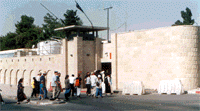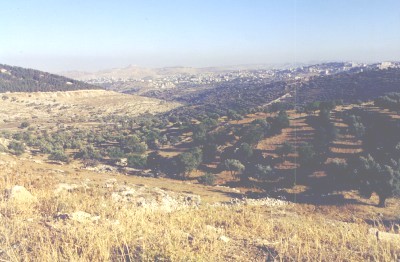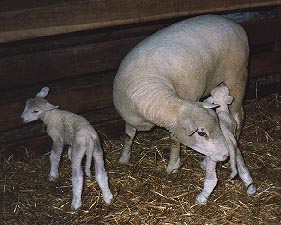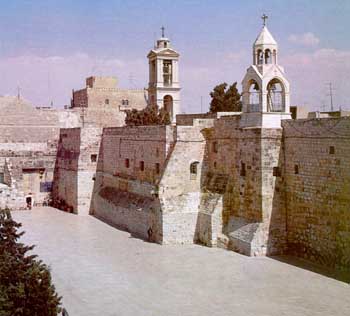The story of Jesus birth as told in Luke, whether some choose to think the manger was in a barn or a cave, leaves little doubt that Jesus was a testimony against the power brokers of His time, and all times. His family wasn't rich, not in wealth at least. His birth wasn't talked about far and wide, except for some shepherds who got the story from some angels. (Luke 2:8) He didn't grow up well known, except for wowing temple scholars with His knowledge. (Luke 2:46-48) He grew up as the son of a carpenter. (Matt. 13:55) Even in His ministry, He had no place to lay His head. (Matt. 8:20) So the idea Messiah, the Savior of "whosoever will" (John 3:16) was born in a cave should encourage us all. God loves and cares about the poorest of the poor, the weakest of the weak, the lowest of the low. The kings and rulers of this world will pass away, but our Savior will endure forever. As will those who love Him. (John 14:2-3)
by Cooper P Abrams III
*All rights reserved.
|
Tradition, not the Bible, says that Jesus' birth place was in cave over which the Basilica of the Nativity was built in Bethlehem. Roman Emperor Constantine, built a Basilica1 over this cave in the 4th Century at the request of his mother, Helena.
- It was
destroyed and the present basilica was built by Emperor Justinian in 530 AD.
Origen of Alexandria (185 - 254 AD) wrote that it was generally accepted that
Jesus was born in a cave at Bethlehem which could be visited in his day. 2
Clearly the city of Jesus' birth was Bethlehem as Micah 5:2
prophesied and as the Gospels of Matthew, Luke and John confirm. (See Matthew
2:1,5-6,8,16; Luke 2:4,15; John 7:42) "But thou, Bethlehem Ephratah, though
thou be little among the thousands of Judah, yet out of thee shall he come forth
unto me that is to be ruler in Israel; whose goings forth have been from of old,
from everlasting." (Micah 5:2)
Luke proclaims the birth place as Bethlehem, "For unto you is born this day in the city of David a Saviour, which is Christ the Lord." 1 Samuel 17:15, confirms Bethlehem as the City of David, "But David went and returned from Saul to feed his father's sheep at Bethlehem." But where in Bethlehem was Jesus born? The fact is that the New Testament does not mention the exact place in Bethlehem of where Jesus was born nor does the Bible record that Jesus was born in stable attended by donkeys, chickens, and cows as many nativity scenes present? All the New Testament says is that there was no room in the inn and that Jesus was lain in a manger in Bethlehem.
The New Testament does not mention a stable or that Jesus was born in the back of an inn. The actually place of Jesus' birth was not certainly not a accident, but was a sign given 700 years earlier which predicted where He would be born. The popular conception that the word "manger" refers to a trough where animals were fed may be accurate. However, it could mean simply a stall. The Greek word which is translated in our English Bibles "manger" is Yatnh phat-ne (pronounced fat'-nay). The definition of the word is of a "stall" where animals are kept and in Luke 13:15 is translated as such.
In the Septuagint (Greek translation of the Old Testament) the word means a stall or a crib (See Proverbs 14:4). The question is what kind of "stall" or manger is the New Testament referring to and what kind of animal was fed or housed there. Although the New Testament does not tell us where in Bethlehem Jesus was born, the Old Testament does. Micah 4:8 states, "And thou, O tower of the flock, the strong hold of the daughter of Zion, unto thee shall it come, even the first dominion; the kingdom shall come to the daughter of Jerusalem." Thus the Old Testament clearly states that the Messiah would be born at the "tower of the flock" (Hebrew: Migdal Edar). The phrase "tower of the flock" is the Hebrew phrase "Migdal Edar" [mig-dawl ay-der] and means a "watch tower of the flock".
In ancient times this was a military tower erected to view into the valley on the edge of Bethlehem to protect the city. Several of these military towers are recorded in the Old Testament (See Judges 8:71, 9:46, 9:51; 2 Kings 9:17, 18:8; Nehemiah 3:1) The tower at Bethlehem is first mentioned in Genesis 35:21, "And Israel journeyed, and spread his tent beyond the tower of Edar" ("tower of Edar" - Migdal Edar). After Jacob left Bethel he came to Edar (the tower) and there Rachel began hard labor and as she delivered Benjamin she died and was buried there in Ephratah which is Bethlehem" (Gen. 35:19). After burying Rachel, Jacob moved his flocks beyond the tower of Edar. This would pinpoint the location as being near to what is present day Bethlehem. Clearly, this establishes that Migdal Edar, "the tower of the flock" was in Bethlehem in Bible times.
 Rachel's Tomb Before it was annexed by Israel (before 1995)  Rachel's Tomb today (since 1995) |
|
A passage from the Mishnah (Shekelim 7:4) 3 leads to the conclusion that the flocks which pastured there were destined for Temple sacrifices..."4 In addition, Migdal Edar is also mentioned by the Jewish Targums and is translated "The Anointed One of the flock of Israel". 5 Thus, Targum Yonatan, cited by Rabbi Munk, paraphrases Genesis 35:23 and Micah 4:8, "He spread his tent beyond Migdal Edar, the place where King Messiah will reveal Himself at the end of days."
What are we to make of all of this information from the writings of the rabbis? First, we know that Migdal Edar was the watchtower that guarded the Temple flocks that were being raised to serve as sacrificial animals in the Temple. These were not just any flock and herd. The shepherds who kept them were men who were specifically trained for this royal task. They were educated in what an animal, that was to be sacrificed, had to be and it was their job to make sure that none of the animals were hurt, damaged, or blemished."6 These lambs were apparently wrapped in "swaddling cloths" to protect them from injury and also used to wrap the Lord Jesus. Thus, with the establishment of Temple worship in Jerusalem, the fields outside of Bethlehem became the place where a special group of shepherds raised the lambs that were sacrificed in the Temple. Being themselves under special Rabbinical care, they would strictly maintain a ceremonially clean stable for a birthing place. The Tower of the Flock was used for birthing ewes, and the surrounding fields were where these shepherds grazed their flocks. These shepherds customarily kept their flocks outdoors twenty-four hours a day every day of the year, but brought the ewes in to deliver their lambs where they could be carefully cared for. It was to this place that Joseph took Mary. It was in this special place at "Migdal Edar" that Christ was born! How do we know? The Micah 4:8 tells us so!7
Prophetically, "Migdal Edar" is the exact place in Bethlehem for Christ to be born. Micah was God's prophet who was warning Israel of the coming captivity. He used the authenticating prophecy of the Assyrian captivity of the Northern Kingdom (soon to occur when he foretold it) to serve as a reminder to Israel of God's promised Kingdom. God wanted them to know that even though they would be taken from their land because of their disobedience that He would restore them in time. Micah 4:7 establishes the context of the passage and clearly is a Messianic prophecy of the coming of the Millennial Kingdom when Jesus Christ will reign over Jerusalem forever. ". . .LORD shall reign over them in mount Zion from henceforth, even for ever." In other words God was assuring Israel that He would fulfill His promises to them of the Kingdom. In Micah 4:8 the word is rendered "tower of the flock" (marg., "Edar"), and is used as a designation of Bethlehem, which figuratively represents the royal line of David as sprung from Bethlehem.8
In this setting, Micah (Micah 4:8) uses the prophecy of the Babylonian captivity of the Southern Kingdom as a pledge to guarantee (authenticating prophecy) of the birth of Christ at "Migdal Edar" at Bethlehem which is exactly where it took place! Micah prophesied that as surely as Assyrians would soon carry away Israel in the North, so the Messiah would come and establish His kingdom, the "first dominion, the kingdom shall come to Jerusalem." The verse states that as surely as Babylon would carry away the Judah, in the South, into captivity, so the Messiah would arrive at the Tower of the Flock. This prophecy was one other evidence that later proved the Jesus was the Messiah, but one that Israel ignored in rejecting Him as their Messiah.
Who were the shepherds
who first received the news of the birth of the Messiah?
The angels only told the shepherds that they would find the Babe wrapped in "swaddling cloths and lying in a manger." There was no need for the angels to give these shepherds directions to the birth place because they already knew. These were the men who raised sacrificial lambs that were sacrificed in the Temple. When the angelic announcement came, they knew exactly where to go, as Luke 2 indicates, for the sign of a manger could only mean their manger at the tower of the flock! You cannot explain the meaning or direction of the sign they were given or their response unless you have the right manger and the right shepherds!9

He was born in Bethlehem, at the birthing place of the sacrificial lambs that were offered in the Temple in Jerusalem which Micah 4:8 calls the "tower of the flock." John the Baptist in John 1:29 proclaimed of Jesus, "Behold the Lamb of God, which taketh away the sin of the world." Jesus is presented in the Bible as being "in type" as a sacrificial lamb. It was not by chance but by choice that Christ identified His death with the time of the observance of the Passover. Peter spoke of our redemption as wrought by the "precious blood of Christ, as of a lamb without blemish and without spot"( 1 Pet. 1:19); and Paul told us that "Christ our Passover is sacrificed for us" ( 1 Cor. 5:7). Even the first fulfilled type by which Christ is to be revealed in Heaven is as the Lamb (Rev. 5:6-13)10 .

Concluding remarks
Is the cave under the Basilica of the Nativity the birth place of
Jesus?
Edersheim says that Migdal Edar was close to the town, on the road
to Jerusalem11. A modern
topographical map shows the traditional place of the Shepherd's Field as being
about 300 meters from the Basilica of the Nativity on the edge of Bethlehem.12 The site has a long history as the place of the birth of
Christ going back to Origen of Alexander in the 2nd Century who said that Jesus
was born in a cave located in Bethlehem.13 It is entirely possible that this cave or grotto was used to keep sheep and that this is where the tower of the flock was located, but it has not been proved. Other's have purported the location of the "tower of the flock" in another location in the vicinity which has not been thoroughly excavated. The tower of the flock being a tower built of stones does not exist today and archaeology has not found its ruins. However, based on biblical record, Micah 4:8, and other evidences we must conclude that it was not the stable of an inn were donkeys and other animals were kept was not a tower. God's word tells us that Jesus Christ was born in Bethlehem, of Judah in the city of David at a place called the "tower of the flock," It is not important that we can go today to the exact spot where He was born. And even if we could, would that help us spiritually? I have been to Israel and seen Jerusalem, and a many of biblical places, but what I saw has little semblance to what it looked like in Jesus' day. For a time I tried to imagine what it looked like during Bible times, but it proved to be a futile effort.
As a student of the Bible I also realized that God is not through with this area and this very place the Lord Jesus will return and set up His earthly Kingdom, which He promised to the Jews. It is going to greatly changed again in the future. What really got my spirits lifted and my mind souring was the realization that as a child of God, born again by Holy Spirit, saved by God's free gift of grace, through the shed blood of Jesus Christ, I too one day will return to Israel and will abide in His Millennial Kingdom and serve the Lord throughout all eternity. His coming, His life, death, burial and resurrection has assured me of that truth. The significance of His birth is that in God's time Jesus came exactly as God promised and that as sure as His past promises have been kept, so will His promises for the future. By the way, that was the promise in Micah 4:8. I rejoice and thank God for His sure promises. Galatians 4:4-5
"But when the fulness of the time was come, God sent forth his Son, made of a woman, made under the law, To redeem them that were under the law, that we might receive the adoption of sons."
End Notes:
1 Basilica. An oblong building ending in a semicircular apse used in ancient Rome especially for a court of justice and place of public assembly. Later the name was used to describe an early Christian church building consisting of nave and aisles with clerestory and a large high transept from which an apse projects and given ceremonial privileges by the Roman Catholic church.
2 Origen of Alexandra, "Against Celsus" in Volume 1, Chapter 51. "In regards to the birth of Jesus in Bethlehem, if anyone, after studying Micah's prophecy and the history recorded in the sacred writings by the disciples of Jesus. If needing to have additional sources of evidence, Let him be aware that the Scriptures are confirmed and the Gospel involving his birth, for there can be seen the cave located in Bethlehem where He was born and the manger where He was wrapped in swaddling-clothes. And this site is talked about with great interest in all the surrounding countries. Even among the enemies our faith it is being said that in this cave Jesus was born, the One who is worshiped and revered by the Christians."
3 Mishnah. The Mishnah was the first recording of the oral law of the Jews or its Rabbinic Judaism. The word means "repetition" which means it was memorized material. It is the major source of rabbinic teachings of Judaism. Next to the Scriptures the Mishnah is the basic textbook of Jewish life and thought, and is traditionally considered to be an integral part of the Torah revealed to Moses on Mount Sinai.
4 Alfred Edersheim, The Life and Times of Jesus the Messiah, From the manger in Bethlehem to the baptism in Jordan, The nativity of Jesus the Messiah, Book 2, Chapter VI, Hindrickson Publishers:1993, p131.
5 Targum. The Targum is an Aramaic translation of the Hebrew Bible (Tanak) which was written during Israel's seventy year captivity in Babylon. Aramaic is one of the Semitic languages, an important group of languages known almost from the beginning of human history and including also Arabic, Hebrew, Ethiopic, and Akkadian (ancient Babylonian and Assyrian).
6 Rabbi Mike L. Short, Migdal Edar,http://www.mayimhayim.org/Rabbi%20Mike/Migdal%20Eder.htm
7 James E. Smith, Where was the Birth Place of the Lord Jesus, Baptist Bulletin December 1979.
8 M.A. Easton, Easton's Illustrated Bible Dictionary,Third Edition, published by Thomas Nelson, 1897.
9 Edersheim, p131.
10 Smith.
11. Edersheim, 131.
12 Bethlehem City - Palestine, Sacred Destinations http://www.sacred-destinations.com/israel/bethlehem-map
13 Origen.
